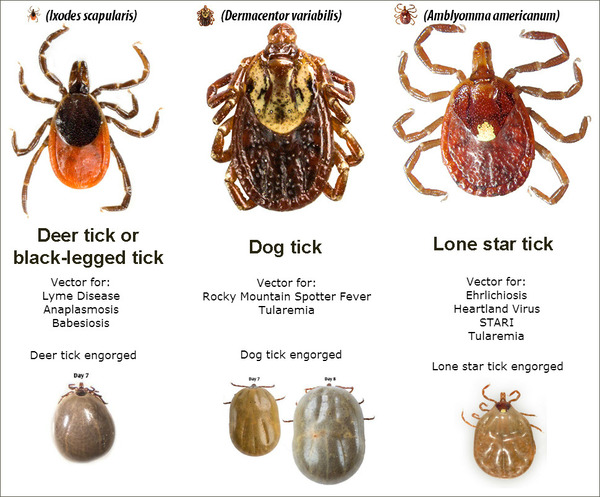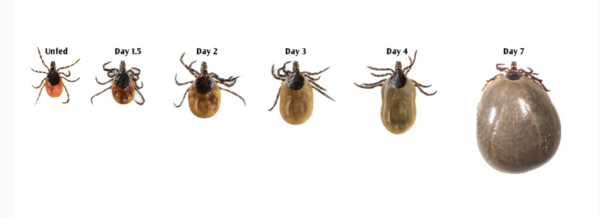As tick season rolls in, it’s important to take steps to protect yourself and your family from these pesky pests. Ticks can carry serious diseases like Lyme disease, so understanding how to manage them naturally is key. Here’s a straightforward guide to keeping ticks away from your yard and yourself.

Ticks are tiny bugs that belong to the arachnid family, which also includes spiders. There are two main types of ticks: soft ticks and hard ticks. While there are around 900 species, only about 60 can bite and spread diseases. The most common types include:
Deer Tick (Blacklegged Tick): Known for spreading Lyme disease.
Lone Star Tick: Recognizable by the white spot on its back.
American Dog Tick: Often found in grassy areas.
Brown Dog Tick: Commonly infests homes and pets.
Ticks love damp, shady spots, especially near tall grass and bushes. They often hitch a ride on animals like deer, rodents, and even your pets.
Ticks can transmit various illnesses, including:
Lyme Disease: Causes a rash and flu-like symptoms.
Rocky Mountain Spotted Fever: Can lead to fever and rash.
Babesiosis: Similar to malaria, causing chills and fever.
Anaplasmosis: Affects white blood cells and causes flu-like symptoms.
If a tick bites you, saving the tick can help with identification and treatment.
Ticks are tiny parasites that feed on the blood of animals and humans, and they are known to carry several serious diseases. Among the many types of ticks, deer ticks, dog ticks, lone star ticks, and wood ticks are some of the most commonly encountered. Each tick species has its own characteristics, preferred habitats, and health risks, making it important to distinguish between them.
In this article, we’ll compare these four tick species to help you understand their differences and the dangers they pose. We’ll also provide a helpful comparison table for a quick reference.
These four ticks are all blood-feeding arachnids, but they vary in appearance, behavior, and the diseases they carry.
The deer tick (Ixodes scapularis), also known as the black-legged tick, is a small tick primarily known for transmitting Lyme disease. It is often found in wooded areas, especially where deer are present.
The dog tick (Dermacentor variabilis) is larger than the deer tick and prefers to feed on dogs but can also bite humans. It is the main vector for Rocky Mountain spotted fever.
The lone star tick (Amblyomma americanum) is easily recognized by a distinctive white spot (or "lone star") on its back. It is common in the southeastern United States and is known for transmitting diseases like Ehrlichiosis and Southern Tick-Associated Rash Illness (STARI).
The wood tick (Dermacentor andersoni), also known as the Rocky Mountain wood tick, is similar to the dog tick but is more commonly found in the western United States. It can transmit diseases like Rocky Mountain spotted fever and Tick-borne encephalitis.
Let’s compare these four ticks in terms of size, appearance, habitat, diseases they carry, and prevention tips.
| Feature | Deer Tick (Black-legged Tick) | Dog Tick (American Dog Tick) | Lone Star Tick | Wood Tick (Rocky Mountain Wood Tick) |
|---|---|---|---|---|
| Scientific Name | Ixodes scapularis | Dermacentor variabilis | Amblyomma americanum | Dermacentor andersoni |
| Size | 3-4 mm (adult, unfed) | 3-5 mm (adult, unfed) | 4-6 mm (adult, unfed) | 4-6 mm (adult, unfed) |
| Color | Reddish-brown with dark shield-like area | Brown with light-colored scutum (shield) | Brown with a white “lone star” spot | Brown with light-colored scutum (shield) |
| Habitat | Wooded areas, brush, areas with deer | Grassy fields, roadsides, near pets | Forested areas, fields, near wildlife | Grassy areas, forests, western U.S. |
| Preferred Hosts | Deer, humans, small mammals | Dogs, humans, larger mammals | Humans, deer, other mammals | Dogs, humans, large mammals |
| Diseases Carried | Lyme disease, Anaplasmosis, Babesiosis | Rocky Mountain spotted fever, Tularemia | Ehrlichiosis, STARI, Tularemia | Rocky Mountain spotted fever, Tick-borne encephalitis |
| Risk to Humans | High (Lyme disease) | Moderate (Rocky Mountain spotted fever) | Moderate to high (Ehrlichiosis, STARI) | Moderate (Rocky Mountain spotted fever) |
| Symptoms in Humans | Fever, fatigue, rash, joint pain (Lyme) | Fever, rash, muscle aches (RMSF) | Fever, headache, rash, joint pain | Fever, rash, muscle pain (RMSF) |
| Prevention | Use tick repellent, wear long clothing | Use tick repellent, avoid tall grass | Use tick repellent, wear protective clothing | Use tick repellent, avoid wooded areas |
Appearance: Deer ticks are small, with a reddish-brown body and a dark shield-like structure just behind their head. They are most active in wooded areas, particularly where deer are prevalent.
Diseases: The deer tick is best known for transmitting Lyme disease caused by the Borrelia burgdorferi bacteria. It can also transmit Anaplasmosis and Babesiosis.
Health Risks: Lyme disease can cause severe symptoms like fever, fatigue, joint pain, and a characteristic “bull’s-eye” rash. If left untreated, it can lead to chronic health problems.
Prevention: To prevent Lyme disease, use tick repellent, wear long clothing, and regularly check for ticks when you spend time in wooded areas.
Appearance: Dog ticks are larger than deer ticks and have a distinctive white or cream-colored shield on their back.
Diseases: The dog tick is the primary carrier of Rocky Mountain spotted fever (RMSF), a disease caused by the Rickettsia rickettsii bacteria. It can also transmit Tularemia.
Health Risks: RMSF can cause fever, rash, muscle aches, and in severe cases, organ failure. Tularemia can cause fever, skin ulcers, and respiratory issues.
Prevention: Avoid tall grasses and areas where dogs frequent. Use tick repellents and regularly check pets for ticks.
Appearance: The lone star tick is easy to recognize by the distinctive white spot on its back, which resembles a "lone star."
Diseases: The lone star tick can transmit Ehrlichiosis (a bacterial infection) and Southern Tick-Associated Rash Illness (STARI), which can mimic Lyme disease symptoms.
Health Risks: Ehrlichiosis can cause fever, fatigue, headache, and muscle aches. STARI causes a rash similar to Lyme disease but typically lacks the characteristic bull’s-eye rash.
Prevention: Use tick repellents, especially in areas where lone star ticks are common, and wear long clothing when outdoors.
Appearance: The wood tick resembles the dog tick but is mainly found in the western U.S. It also has a light-colored shield on its back.
Diseases: Wood ticks can transmit Rocky Mountain spotted fever and Tick-borne encephalitis, a viral infection.
Health Risks: RMSF from wood ticks causes fever, rash, and potentially life-threatening complications. Tick-borne encephalitis can lead to severe neurological symptoms.
Prevention: Similar to other ticks, avoid tick habitats, wear protective clothing, and apply tick repellent.
Each of these ticks poses different risks, but the key to preventing tick-borne illnesses is prevention. When spending time outdoors in areas where ticks are common:
Use tick repellent containing DEET.
Wear long sleeves and pants to reduce skin exposure.
After outdoor activities, check yourself, your pets, and your children for ticks.
If a tick is found, remove it promptly and properly to avoid the transmission of diseases.
By understanding the deer tick, dog tick, lone star tick, and wood tick, you can better protect yourself, your pets, and your family from the potential dangers of tick bites.
A well-maintained yard can greatly reduce tick populations:
Mow the Lawn Regularly: Keep grass short (3 inches or less).
Clear Debris: Remove fallen leaves, wood piles, and tall weeds where ticks might hide.
Create Sunny Spots: Trim back shrubs and trees to allow more sunlight in, as ticks prefer shady areas.
Use Barriers: Add wood chips or gravel between your lawn and woods to create a buffer.
When you head outside, especially into areas where ticks are common:
Wear Light-Colored Clothing: This makes it easier to spot ticks.
Choose Long Sleeves and Pants: Tuck your pants into your socks to prevent ticks from crawling up.
Use Tick Repellents: Apply EPA-approved repellents containing DEET or picaridin on your skin and clothes.
After spending time outdoors:
Do a Tick Check: Look closely at your skin, especially in hidden spots like armpits and behind the knees. Don’t forget to check your pets too!
Shower and Change Clothes: A hot shower and clean clothes can help wash away any ticks before they attach.

Here are some easy, natural ways to keep ticks away without using harsh chemicals:
Ticks dislike the smell and taste of apple cider vinegar. Mix 2 cups of water with 4 tablespoons of apple cider vinegar and spray it on your clothes and skin. You can even spray it on your pets (just avoid their eyes).
Neem oil is a natural repellent. Dilute it with a carrier oil (like almond oil) and apply it to your skin. Avoid applying it directly onto a tick.
Many essential oils repel ticks, including citronella, eucalyptus, and lavender. Mix a few drops with a carrier oil and apply it to your skin or clothes.
Cedar oil can kill and repel ticks. Mix it with water and witch hazel to create a spray that can be applied to skin and clothing.
This oil can also help keep ticks away. Mix a few drops with a carrier oil or water and spray it on your skin.
These birds love to eat ticks! Having a few chickens or guinea fowl in your yard can help control the tick population while providing fresh eggs.

If you discover a tick on your skin, here’s what to do:
Remove the Tick Carefully: Use fine-tipped tweezers to grasp the tick close to your skin and pull straight out. Avoid twisting or jerking it, as this can break off parts of the tick.
Save the Tick: Put it in a sealed container. If you develop symptoms later, you can show it to your doctor.
Watch for Symptoms: After removal, keep an eye out for any signs of illness, such as rash or fever.
By keeping your yard tidy, dressing appropriately, and using natural remedies, you can greatly reduce the chances of ticks invading your space. Stay alert during tick season, and enjoy your outdoor activities safely!
animal tags: ticks
We created this article in conjunction with AI technology, then made sure it was fact-checked and edited by a Animals Top editor.